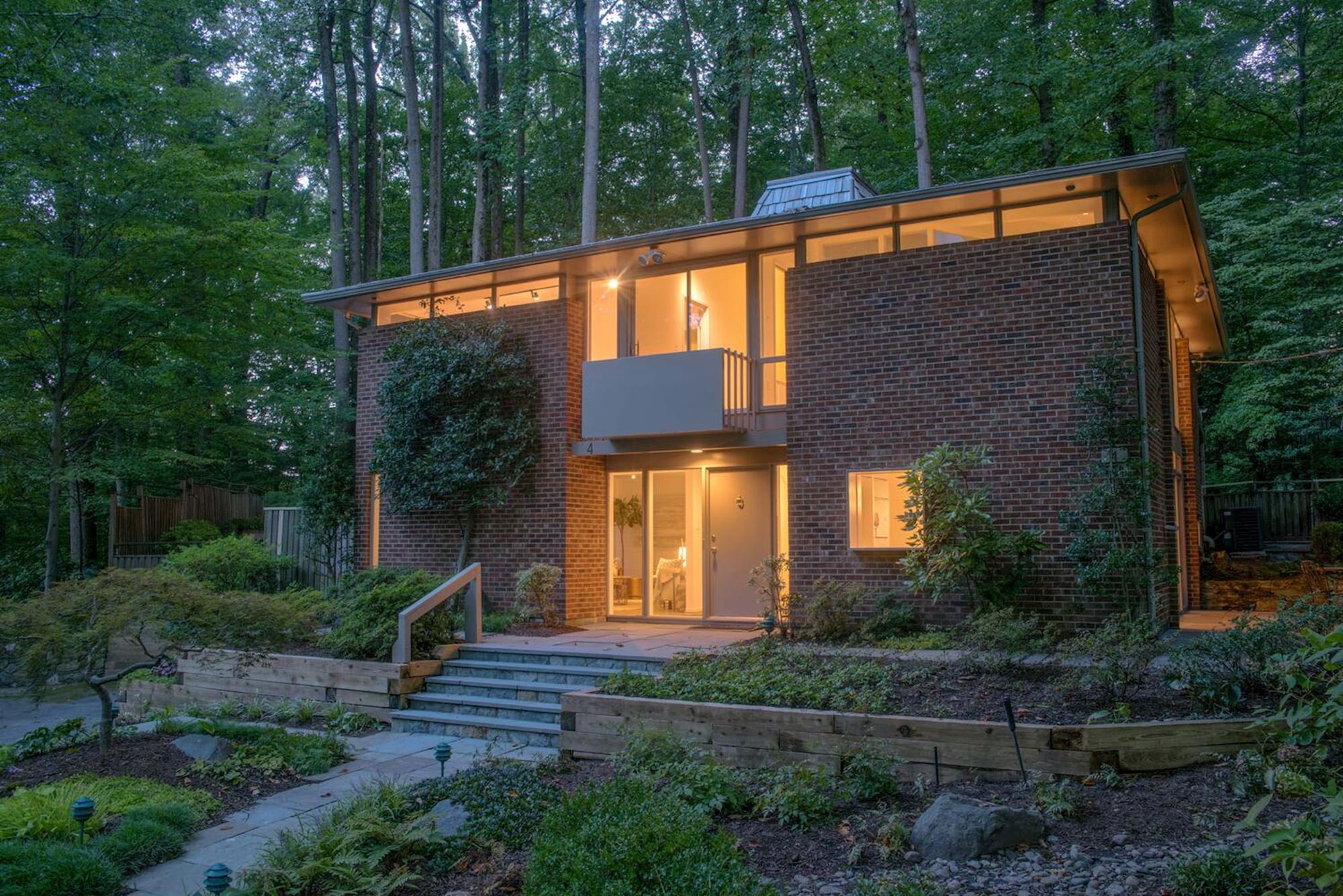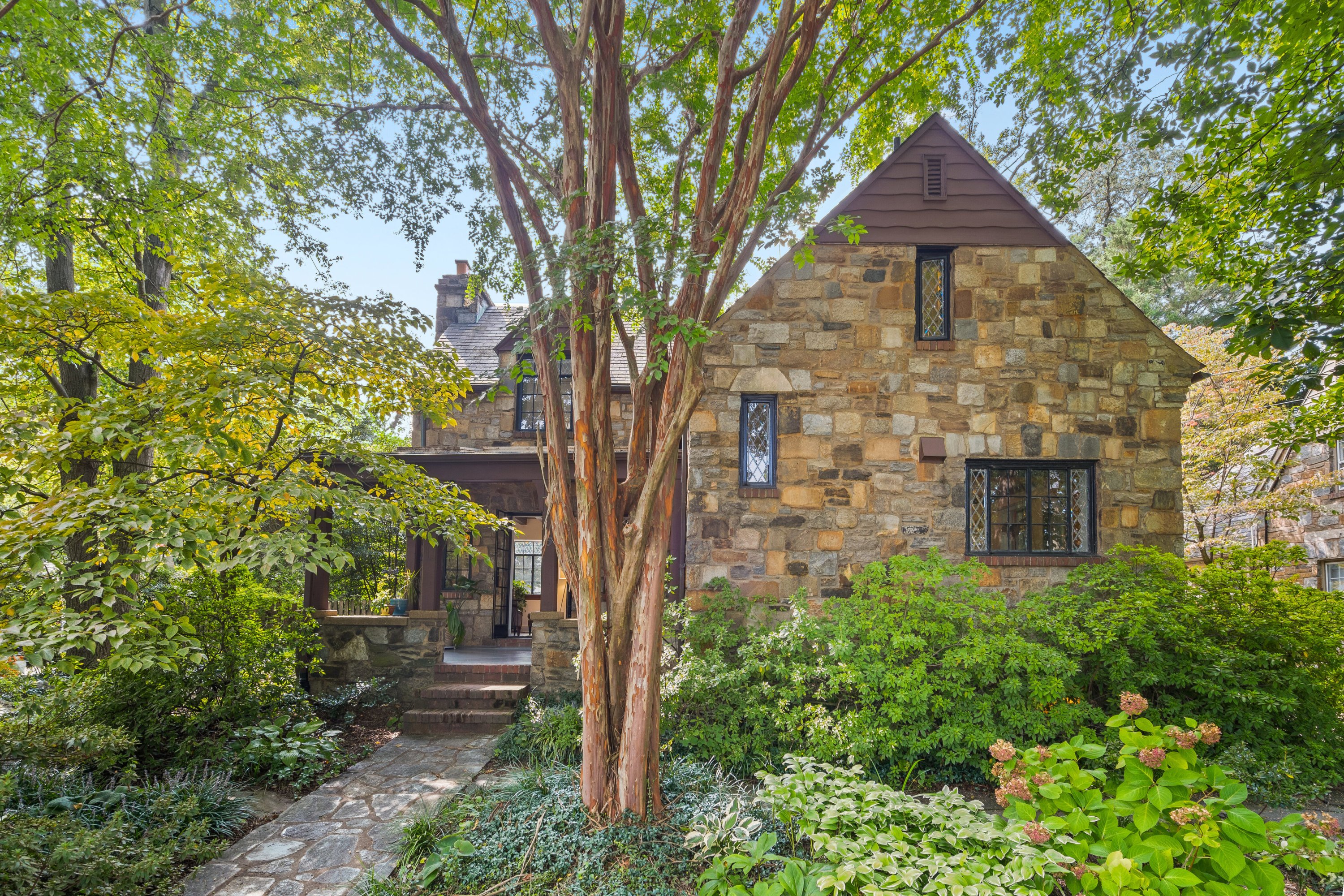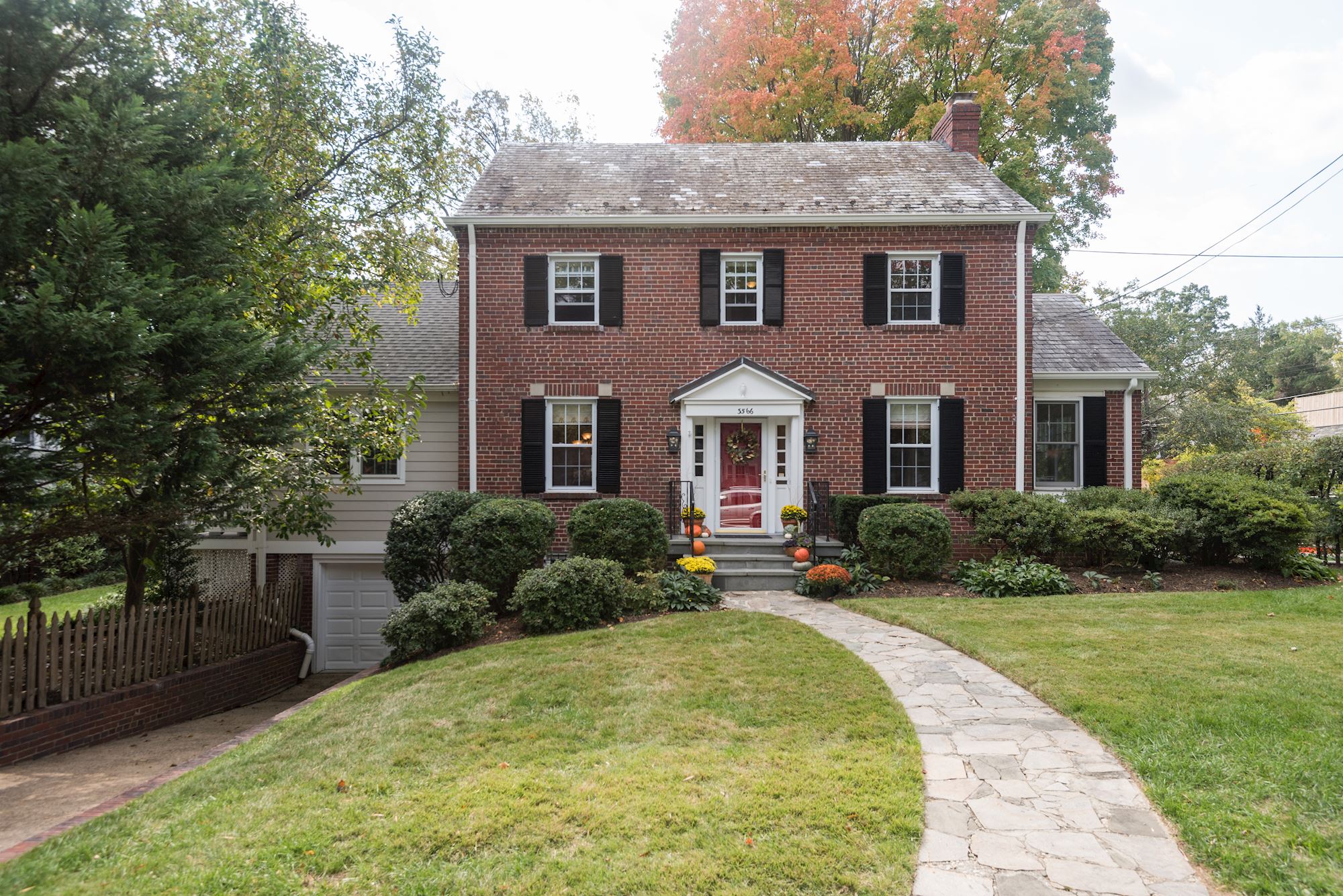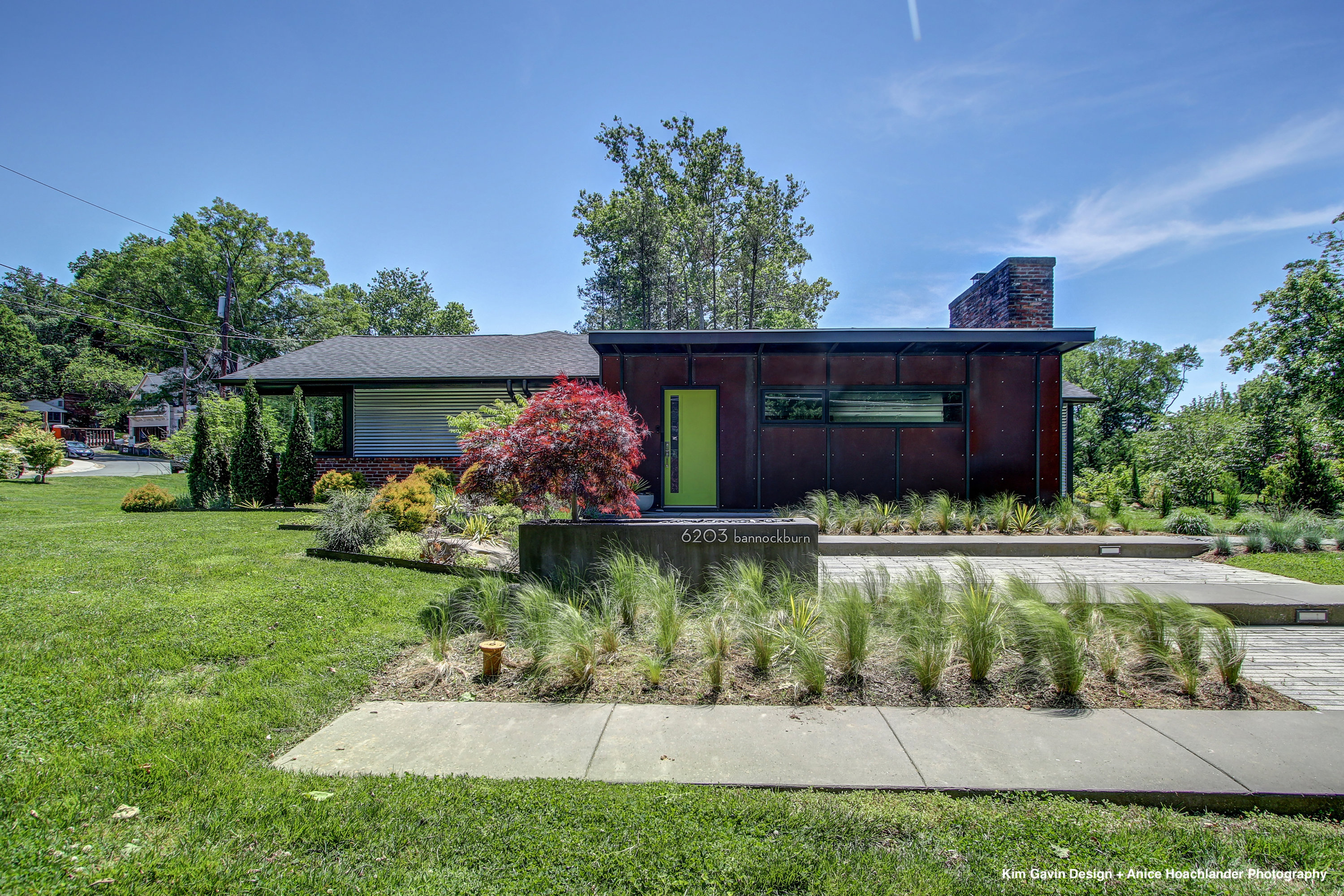On a blue-sky Saturday last September, David Abrams arrived a half hour early to his listing at 4 Wynkoop Court in Bethesda. He made his way through the checklist of new tasks that real-estate agents have had to master during the pandemic: opening windows, setting up hand-sanitizer stations, wiping down surfaces.
Abrams anticipated that the three-bedroom midcentury-modern would attract considerable attention, given its unusual architecture and desirable location. But he wasn’t prepared for what he saw out the window 15 minutes before go time. The line of people was dozens long and already snaking around the cul-de-sac. Abrams felt his anxiety spike. Is this safe?, he wondered.
It was six months into a global pandemic. Nationally, 740 people were succumbing to coronavirus every day. Public-health officials were advising Americans to avoid crowded places and indoor gatherings. And millions of people were out of work.
For a time, agents had reason to believe they could wind up among them. Washington’s bustling real-estate market slammed on the brakes when Covid first hit last spring. Buyers called off their searches. Sellers pulled listings. Those in the real-estate industry panicked. BEST HOUSING MARKET IN A DECADE COULD SUCCUMB TO CORONAVIRUS, warned a March 2020 Bloomberg headline.
“It was like, We’re never going to sell a house again,” recalls Hans Wydler, who has been in the business 20 years.
“I was a zombie,” says Alexandria agent Micki MacNaughton. “I told my husband, ‘Cancel everything we don’t need.’ I’m like, ‘Are we watching Hulu? Cancel that.’ ”
But by the time the shoppers were lined up at 4 Wynkoop, agents didn’t have to worry about paying for Hulu—though they might not have had time to watch it. The market was more frenzied than it had been in 15 years. July had been the most expensive month ever for DC-area real estate.
On one level, the situation was a searing example of Washington’s status as one of the nation’s most unequal regions: Despite soaring unemployment, despite shuttered restaurants and shops, despite the many residents struggling to afford groceries, the local homebuying population had not only grown wealthier—it was hungrily looking for a change of scenery.
That’s the big national story, at any rate. Down on the pavement, where crowds were lining up in places like Bethesda, it meant that would-be homebuyers were feeling like gladiators. And it meant that professionals such as David Abrams were suddenly feeling more like traffic cops—and public-health monitors—than like listing agents. As he stood on the porch chatting with people who’d waited 40 minutes to get in, he did his best to enforce social distancing. “The way I could tell how many people were in the house was by the number of shoes at the door,” he says. “I was looking in the window from the front, counting shoes.”
By the end of the afternoon, he estimates that 120 people had come through. On top of that, the home also had more than 115 private showings in six days on the market. When Abrams tallied the offers that rolled in, he could hardly believe it—20 in all. The house had been listed for $949,000. The triumphant bidders, a pair of lawyers, paid $1.2 million.

People in Washington these days don’t really buy houses. They win them. There was the picturesque Tudor in Silver Spring that asked $798,000, then sold for $943,000 after reeling in 22 offers. There was the modern three-bedroom near Glen Echo that also got 22 bids—despite that its owner didn’t allow an open house and required everyone who made a private appointment to first show proof of approval by a lender. That one asked $899,000 and sold for more than $1.1 million.
There was the place in North Cleveland Park, where so many people wanted to get in that listing agent Amy Levin had to reprogram the lockbox to allow for 24-hour access. The brick Colonial was priced at $1.595 million and got $1.775 million. After that, says Levin, “I called the 12 other people I’ve ever sold houses to over there and was like, ‘You’ve gotta get your house on the market.’ ”
And then there was the five-bedroom in Alexandria with the great backyard. On the afternoon of the open house, listing agent Marian Rosaaen turned onto the cul-de-sac and at first couldn’t make sense of the crowd: “Hand to God, I said, ‘Is someone having a block party right now?’ ” The home, listed for $624,500, got 54 offers. Fifty-four. (As of press time, the sale hadn’t closed.)
Interviews with more than two dozen local agents turn up similar stories from one side of the Beltway to the other, one jaw-dropping scenario after another. They also reveal an explanation for what’s going on—a trend that long preceded the calamitous arrival of Covid.
As anyone who’s tried to buy a house in the last decade knows, Washington has been in the throes of a worsening housing shortage since the Great Recession. The last time the area had a six-month supply of homes for sale—the threshold for a balanced market—was nearly 12 years ago, according to the real-estate site UrbanTurf. For the past couple of years, the supply has hovered mostly between one and a half and two months, according to Bright MLS, the listing service that local agents use. All the while, prices have risen and regional leaders have fretted about housing costs scaring away the middle class and damaging the region’s ability to compete.
Now add in a global health crisis that dramatically changed what people wanted out of their houses, a big population of white-collar Washingtonians whose job security has been unscathed by Covid, a Wall Street hot streak that has helped the stock portfolios of affluent buyers, and interest rates below 3 percent. The result? A surge in extremely motivated house-hunters fighting over an even more depleted number of options. The latest data, in fact, shows that inventory has plummeted to a one-month supply, meaning that if new listings were to dry up entirely, currently available houses would sell out in a mere four weeks.
So far, there’s little hope for improvement: Though they might be tempted by the potentially astronomical profits, plenty of would-be sellers remain on the sidelines thanks to Covid’s distorting impact on the law of supply and demand. It’s hard to put your house up for sale, after all, when you’re not sure where you’ll be able to go next.

So the mad scramble gets madder. “I’ve been a bouncer at some of our open houses,” says Alexandria agent Brittany Patterson. “We’ve seen people try to cut in line. It’s a little like kindergarten.”
Another reason showings need crowd control is that a lot of sellers are loath to let too many people in—either to limit their exposure to the virus or simply because they’re stuck at home. Such was the case with a townhouse in a beyond-the-Beltway part of Silver Spring, on the market for less than $500,000. It had been listed on a Thursday, with an offer deadline only two days later. “The owner was still living in the house and was working, so there were huge chunks of time you couldn’t get in. It was booked solid,” says agent Peggy Ferris, whose clients were desperate to see it.
Tellingly, the inconvenient situation didn’t hurt the sale. In a last-ditch attempt, Ferris and her buyers decided to show up without an appointment. “We sat outside trying to get in at, like, 5:30 at night before the offers were presented,” says Ferris. Finally, word came down from the seller’s agent—they already had 15 offers. No one else would be allowed inside.
In fact, the real house-hunter’s dream is to avoid the insanity altogether by finding a home before it’s publicly listed. A couple I’ll call Ben and Lisa (who, to speak candidly about finances, didn’t want their real names used) thought they had struck gold when their agent, Jen Walker, got a lead on a Rosemont house whose owners wanted to sell off-market. As far as Ben and Lisa knew, they were the first ones in the door. They fell in love, booked an inspection for the very next morning, and handed in a full-price contract that night. Then . . . silence. Turns out a neighbor had seen their home inspector, caught on to what was happening, and swooped in with an all-cash offer. “It was just like, Are you kidding me?” says Lisa.
About a month later, in September, Walker emailed with another option. She knew a developer with approved plans to build a five-bedroom house, also in Rosemont. One catch: It would cost about $300,000 more than Ben and Lisa’s original $1.5-million budget. And another thing: It might not be finished until August 2021. At that point, Ben and Lisa—along with their dog and toddler son—had been quarantining in their two-bedroom Logan Circle condo since March. Every trip outside required navigating a germ gauntlet of shared door handles and elevator buttons. “We have a two-year-old who wants to put whatever’s closest at hand into his mouth,” explains Ben.
But August sounded better than never. They went for it.
If the booming prices are a continuation of a longstanding reality, the contours of the current market represent a dramatic shift from recent trends. For the better part of the 21st century, as the urban population swelled and public policy reoriented to promote transit and walkable neighborhoods, the condo market shot up—in central DC as well as in built-up suburbs like Bethesda and Arlington. Things were more sluggish, on the other hand, in leafy, car-dependent areas.
But Covid has changed our sense of space, not to mention our interest in sharing that space with strangers. Though the red-hot market has encompassed large parts of the District, the blocks upon blocks of glassy new condos and apartments are distinctly cold. More people in the city tried to unload those units in 2020 than ever before on record, with condo inventory up by 17 percent compared with 2019. Arlington and Bethesda also saw a deluge of condos hit the market—their inventories were up by nearly 30 percent and 13 percent, respectively.

The consensus among agents is that unless a unit has two or more bedrooms and private outdoor space, it’s likely to be a dud, at least for now. There’s the ick factor of communal living, of course, but the contingent of would-be con-do buyers—often a younger demographic on a tighter budget—has also been harder hit economically. Meanwhile, the other population of recent condo buyers—baby boomers downsizing to an urban pied-à-terre—are newly aware of their vulnerability and less keen on moving downtown. Plus, with their twentysomething kids moving home due to the pandemic, they’re temporarily no longer empty-nesters.
“This was the first time in a very, very long time that we had move-in-ready, almost underpriced product just sitting on the market,” says broker Lindsay Dreyer of her condo listings. She points to a unit she sold in the fall—a one-bedroom in Columbia Heights. “When I chatted with [the seller], I was like, ‘If you sold a year ago, we could have gotten 325 or 330.’ ” Instead, the listing spent more than a month on the market before settling for $299,000.
A Roller Coaster Year
Highlights of the pandemic market
April ’20: Amid Covid-19 lockdowns, the number of homes listed for sale this month in the Washington area dropped by more than 37 percent compared with the previous April. The number that went under contract plummeted by 41 percent—the sharpest decline in a decade.
June ’20: With lockdowns loosened—and people growing desperate for more space—the frenzy began. More homes went under contract this month than during any other June in the past decade.
July ’20: Prices were officially soaring. This month, the median cost of DC rowhouses exceeded $800,000 for the first time on record.
October ’20: The median price of single-family detached houses in the District exceeded $1 million for the first time.
December ’20: By the end of the year, the inventory of homes for sale in the area had cratered to one month’s worth of supply for the first time ever. (A six-month supply is considered a balanced market.)
January ’21: The market shows no sign of slowing in the new year. In January, a typically slow month for real estate, listings in Washington lasted an average of only 11 days on the market—15 fewer than in January 2020.
In downtown Bethesda, agent Wendy Banner has a condo that has languished more than 300 days. “It is, in my opinion, a steal,” she says, noting that its location, a block from Metro, would normally have buyers swarming. On the flip side, her megamansions farther out haven’t been this popular in more than a decade. “We started getting calls on every listing that we had in Potomac. Houses that could take years to sell were suddenly being snapped up in a couple weeks’ time.”
With vacations on hold, agents say high-end buyers have been clamoring for swimming pools and sport courts. Not to mention that with lending so cheap, they can get more for their money than ever before. The pandemic, which has revived interest in things like several-acre lots, has lifted the fortunes of places such as Potomac and Great Falls, where home prices grew by 6.2 percent and 16.3 percent, respectively, in 2020 after long stretches of flatlining.
But don’t toll the death knell for city living just yet. While it’s true that buyers at the moment seem to be prioritizing space over urban walkability, it’s not as if all the District’s downtown neighborhoods have tanked. Logan Circle, for instance, saw prices rise by more than 11 percent last year. Shaw had modest growth, at about 2.5 percent. The Zip code that includes H Street and NoMa increased by 4.6 percent.
Not everyone is ready to flee to the burbs, after all, and as agents explain it, the pandemic has turned all levels of homeowners into move-up buyers. “What we’re seeing is the young couple who bought a condo a few years ago and now they’re both working from home and, oh, by the way, they had a baby six months ago and they’re all crowding in 600 square feet,” says agent Dana Scanlon. “They’re looking for the next step up—a two-bedroom with a terrace, or a little rowhouse.”
For anyone who lived through the early-aughts boom and bust, the spectacles of 2021-style house-hunting—the lines of would-be buyers stretching down sidewalks, the sight-unseen offers, the giddiness-inducing financing opportunities—might come with a touch of dread. Are we in a bubble?
First, the good news: The answer appears to be no. Unlike during the overheated market of the Bush era—fueled by reckless lending practices and rampant speculation—today’s buyers must endure rigorous vetting to secure a mortgage. In bidding wars, sellers often perform even more due diligence, reviewing competitors’ finances to confirm who truly has the cash to close the deal.
Jeannette Chapman, director of the Stephen S. Fuller Institute at George Mason University, an authority on the regional economy, also emphasizes that as quickly as prices are appreciating, they’re not rising anywhere near as fast as they would in a bubble: The median Washington home value increased by 8.7 percent in 2020. In 2005, leading up to the crash, it rocketed by nearly 22 percent.
But even without a bubble, the situation is worrisome for other reasons. Rather than lifting all ships, this rising tide has exacerbated inequality. Homeownership was already out of reach for a lot of working-class Washingtonians—a disproportionate share of them people of color—before the pandemic. With those same parts of the population bearing much of Covid’s economic and human toll, the prospect of catching up has become considerably bleaker for them.
“For the region, it’s not healthy that we don’t have enough homes at a lot of different price points,” explains Jenny Schuetz, a senior fellow at Brookings. “It’s a danger if the middle class can’t stay—the middle class is a lot of your tax base.”
Programs designed before the Covid boom to help balance opportunities also often don’t work in the current market. Veteran loans, FHA loans, and teacher programs, for example, typically require that financing and appraisal contingencies be included in offers—clauses that allow buyers to get out of a contract if their loan falls through or the home doesn’t appraise for the sale price. But these days, when competing buyers are liable to waive all contingencies, and when sellers scrutinize bids in search of the most conventional financing or all-cash offers, well-intentioned programs can be meaningless.
“We have lots of very vibrant communities here,” says Peter Tatian, the Urban Institute’s research director for greater DC, “and that’s what’s put at risk if housing costs get way out of line with what average working people can afford.”

Agents and economists do anticipate that the intensity will eventually ebb, at least somewhat. Rather than spawn entirely new buyer preferences, they predict that the pandemic has more likely just accelerated timelines. In other words, many young families crammed into condos were going to want big houses and yards anyway. It’s just that an unprecedented crisis caused more of them to pack up in search of those things seemingly overnight. At some point, the thinking goes, this migration will settle down.
But until then, the lines will keep forming. When he sorted through the stack of offers that came in on 4 Wynkoop Court last fall, Abrams found that 15 of the 20 were for more than $1 million, and most were contingency-free. Surely, amid such aggressive competitors, there were buyers who’d already struck out in multiple other bidding wars.
However, one-half of the winning couple who bought the home, Matthew Aichele, tells me he and his wife visited the open house almost on a whim. From their Penn Quarter condo, they’d been casually perusing online listings, but they hadn’t even hired an agent yet.
Says Aichele: “This was the first house we looked at.”
Unless otherwise stated, statistics about the local real-estate market are from Bright MLS, the listing service that agents in the Washington area use.
This article initially appeared in the April, 2021 issue of Washingtonian.





More Stories
How to Give FSBO’s a Reason to Call You Back
Vail Resorts – 4 Tips to Finding the Best Ski Lodge for Your Money
Prime Bangkok Real Estate East of the City